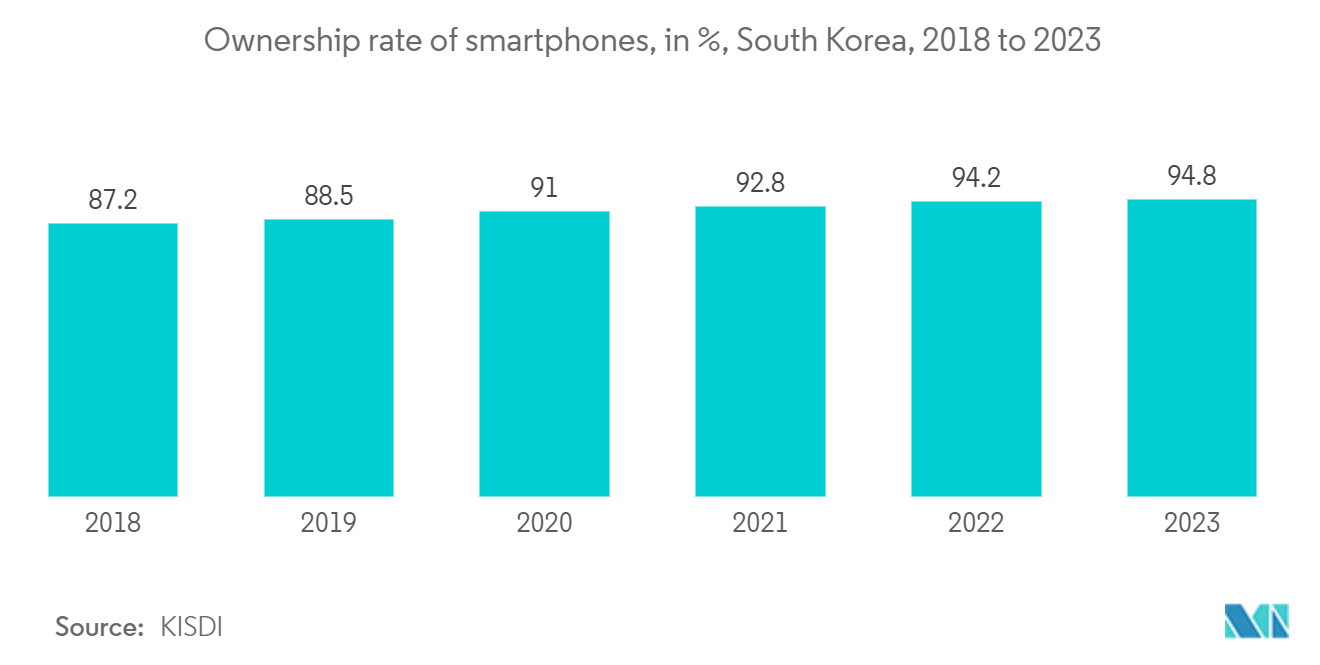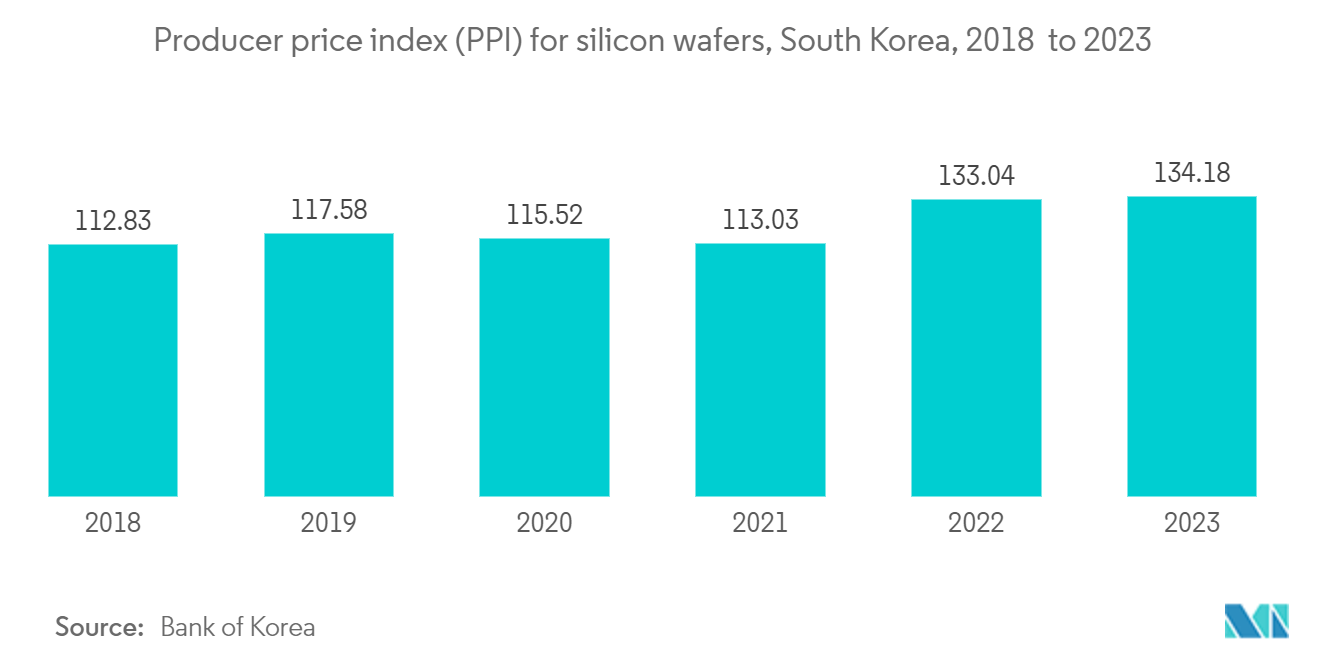Market Trends of Korea Semiconductor Device Industry
The Discrete Semiconductor Segment is Expected to Drive the Market's Growth
- Devices like metal oxide semiconductor field effect transistors (MOSFETs), insulated-gate bipolar transistors (IGBTs), bipolar transistors, thyristors, rectifiers, etc., comprise the discrete semiconductors segment. Some of the main factors influencing the segment's growth include the rising demand for high-energy and power-efficient devices, the increasing prevalence of wireless and portable electronic products, and the increased use of these devices in the automotive industry due to the shift toward electrification.
- Effective power management is one of the critical themes in discrete semiconductors. In Korea, new system architectures are decreasing the size and component count of AC-DC power adapters while increasing their efficiency. Higher power transfer is made possible by new Power-over-Ethernet (PoE) standards, allowing the creation of new classes of devices like connected lighting.
- Several factors, including the underlying physics and the end-user experience, influence consumer adoption and acceptance of wearable technology in Korea. To maintain a competitive edge, discrete semiconductor Korean firms are standing to gain from being aware of the difficulties and market trends during the product design phase. Schottky barrier diodes (SBDs), junction field effect transistors (JFETs), and metal-oxide-semiconductor field-effect transistor (MOSFET) transistors are examples of power electronics devices that can reduce power losses by using a semiconductor with greater mobility and a higher critical breakdown field, such as silicon carbide (SiC).
- Today, one of the most demanded applications for power semiconductors is an uninterruptible power supply, which is typically used to protect hardware like computers, data centers, telecommunication equipment, or other electrical equipment where an unexpected power disruption could cause injuries, fatalities, serious business disruption or data loss. Uninterruptible power supply systems usually contain batteries and an inverter that uses insulated-gate bipolar transistor (IGBT).
- Vendors in the region are utilizing GaN transistors to address data center server power requirements. The high-frequency leg uses GaN switches, while the low-frequency leg utilizes superjunction MOSFETs, hence, enhancing the efficiency by up to 97.5%. The ongoing expansion of hyperscale data centers by cloud computing providers is also fueling the demand for discrete MOSFETs. Further, the use of gallium nitride (GaN) power transistors is gaining traction in many consumer electronics applications, particularly chargers. GaN switch technology has enabled a major advance in the miniaturization of chargers and adapters.
- Discrete semiconductors are used in various electronic products, including smartphones. These semiconductors perform minor electronic functions, including power conversion, voltage regulation, data transmission, and high-definition digital displays in smartphones. Some of the many discrete semiconductors used in smartphones include transistors, diodes, and power devices.
- Around 94.8% of respondents claimed to own a smartphone in a study by the Korea Information Society Development Institute (KISDI) that was conducted in South Korea in 2023, up from about 22% in 2011. Such huge smartphone adoption would drive the market.

The Industrial Segment is Expected to Witness a High Market Growth
- The automation industry has been revolutionized by integrating digital and physical manufacturing aspects to deliver optimum performance. Further, the focus on achieving zero waste production and a shorter time to reach the market has boosted the market's growth.
- According to the International Federation of Robotics Report 2021, showed South Korea had 932 robots per 10,000 members of its population. South Korea has the world's highest density of robots after three years at No. 2. For the first time, the number of industrial robots worldwide surpassed 3 million in 2021.
- In Korea, 342,983 industrial robots were in use as of 2020. According to the International Federation of Robotics (IFR), as compared to 2020, Korean demand for robots increased by 11% in 2021 in the electronics and automotive industries and 8% on average. Such a rise in industrial robots would drive the demand for the studied market.
- In Korea, Industrial 4.0 and the Industrial Internet of Things are at the center of the new technological approaches for developing, producing, and managing the entire logistics chain, otherwise known as smart factory automation. They dominate the industrial sector trends, with machinery and devices being connected via the internet.
- Moreover, huge shifts in manufacturing due to Industry 4.0 and the acceptance of industrial Internet-of-Things (IIoT) require enterprises to adopt smarter, agile, and innovative ways to advance production, with technologies that complement and augment human labor with automation and reduce industrial accidents caused by a process failure.
- Korea's commercial and public sectors have agreed to boost the number of local smart factories, with the objective of having more than 30,000 of them working with the newest digital and analytical technology by 2022.
- The Ministry of Trade, Industry, and Energy (MOTIE) of Korea has reaffirmed the government's ambitions to assist small and medium-sized businesses in adopting and expanding smart manufacturing technology. Small and medium-sized firms (SMEs) account for more than 99% of all businesses in Korea, and government data suggests that SMEs' exports are growing. Such a rise in export value would drive the studied market.
- According to the Bank of Korea, in 2023, South Korea's producer price index (PPI) for silicon wafers surged past 134 points, marking a substantial uptick from 2020 and setting a new record high. The rising trend in production costs for silicon wafers has been evident in recent years.


